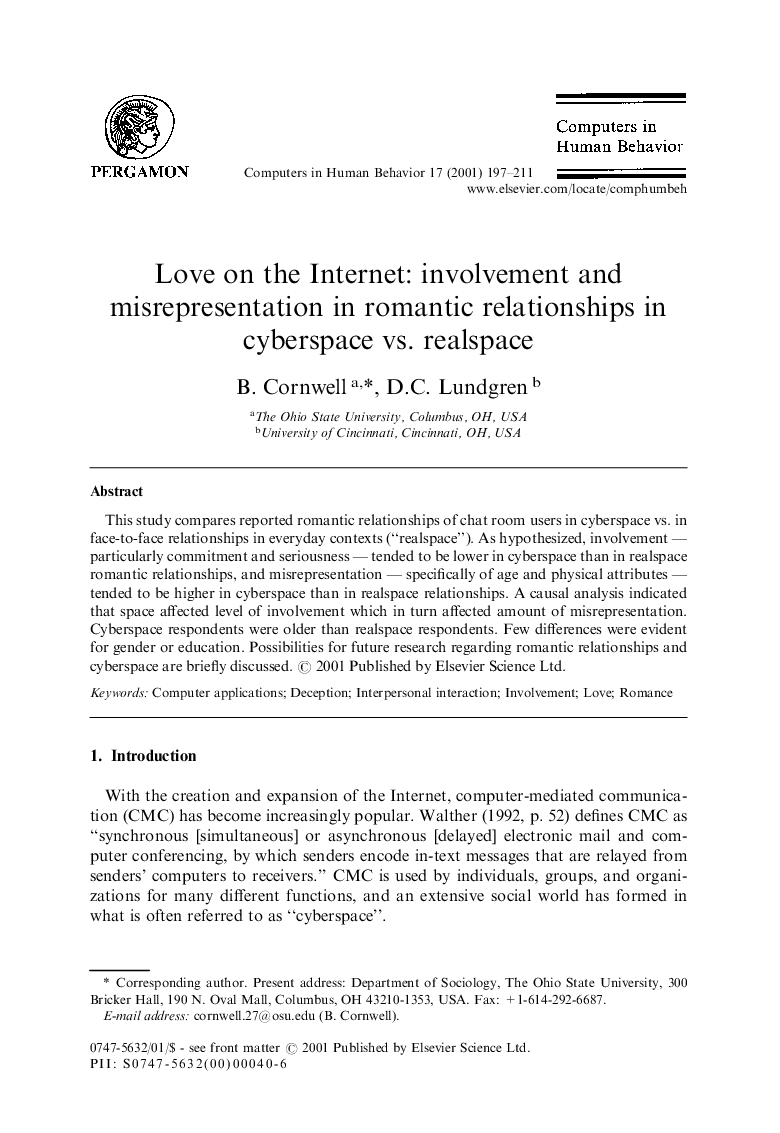This study compares reported romantic relationships of chat room users in cyberspace vs. in face-to-face relationships in everyday contexts (“realspace”). As hypothesized, involvement — particularly commitment and seriousness — tended to be lower in cyberspace than in realspace romantic relationships, and misrepresentation — specifically of age and physical attributes — tended to be higher in cyberspace than in realspace relationships. A causal analysis indicated that space affected level of involvement which in turn affected amount of misrepresentation. Cyberspace respondents were older than realspace respondents. Few differences were evident for gender or education. Possibilities for future research regarding romantic relationships and cyberspace are briefly discussed.
With the creation and expansion of the Internet, computer-mediated communication (CMC) has become increasingly popular. Walther (1992, p. 52) defines CMC as “synchronous [simultaneous] or asynchronous [delayed] electronic mail and computer conferencing, by which senders encode in-text messages that are relayed from senders' computers to receivers.” CMC is used by individuals, groups, and organizations for many different functions, and an extensive social world has formed in what is often referred to as “cyberspace”.
Cyberspace can be viewed as a microcosm of the vast, expansive physical and social world that preceded and exists apart from it (“realspace” as termed here). While numerous comparisons are possible, the most important difference for present purposes is that interaction in realspace is characterized by direct face-to-face communication and contact in immediate physical settings, whereas such events cannot occur in cyberspace. William Gibson, who coined the term “cyberspace”, said of cyberspace that “it's not really a place, it's not really space” (quoted in Leary, 1994, p. 25). Although the social world that constitutes cyberspace occupies virtually no physical space, it does contain vast amounts of information and houses commercial and other business-related communication channels, as well as venues for recreational interpersonal communication. Such networks are made possible by cyberspace's capacity to support e-mail messaging, direct messaging, chat rooms, and similar types of online group interaction. It is chat room interaction and the formation of romantic relationships in chat rooms with which this study is primarily concerned.
Chat rooms are electronic venues on the Internet where people can communicate with other Internet users. Instead of the oral communication that typically characterizes interaction in realspace, the typewritten word serves as the primary form of communication among people in chat rooms. Chat room users are provided with a field at the bottom of their computer screen in which they can enter any message that they wish. Upon clicking a button on the screen with their cursor, users can post a message to be displayed to all other users logged into that particular chat room. In addition, users have the option of sending private messages to particular individuals in the chat room. Upon reading another user's message, chat room users can post their own responses. Many people enjoy using chat rooms because they allow for anonymity. Thus, chat room users can say almost anything they like without others knowing who they are. Because of improvements in computer technology, chat room interactions are nearly synchronous, although the amount of asynchronization varies due to such factors as modem speed, number of users logged on, and variation among CMC systems (Walther & Burgoon, 1992).


